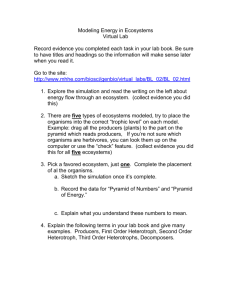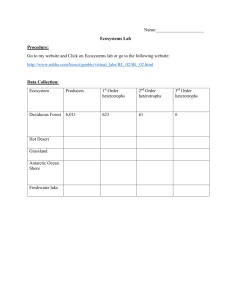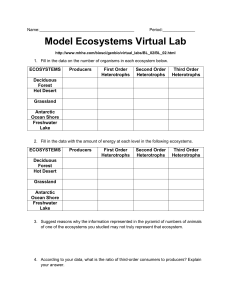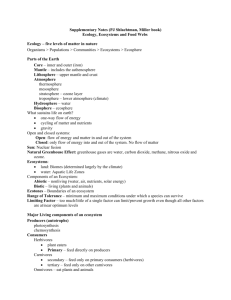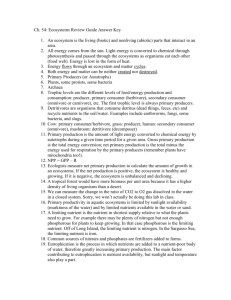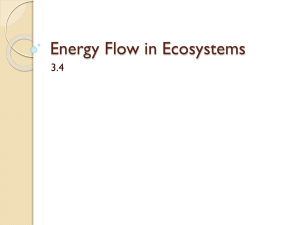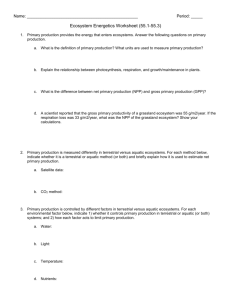Ecosystems: Energy Flow, Productivity, & Cycles
advertisement
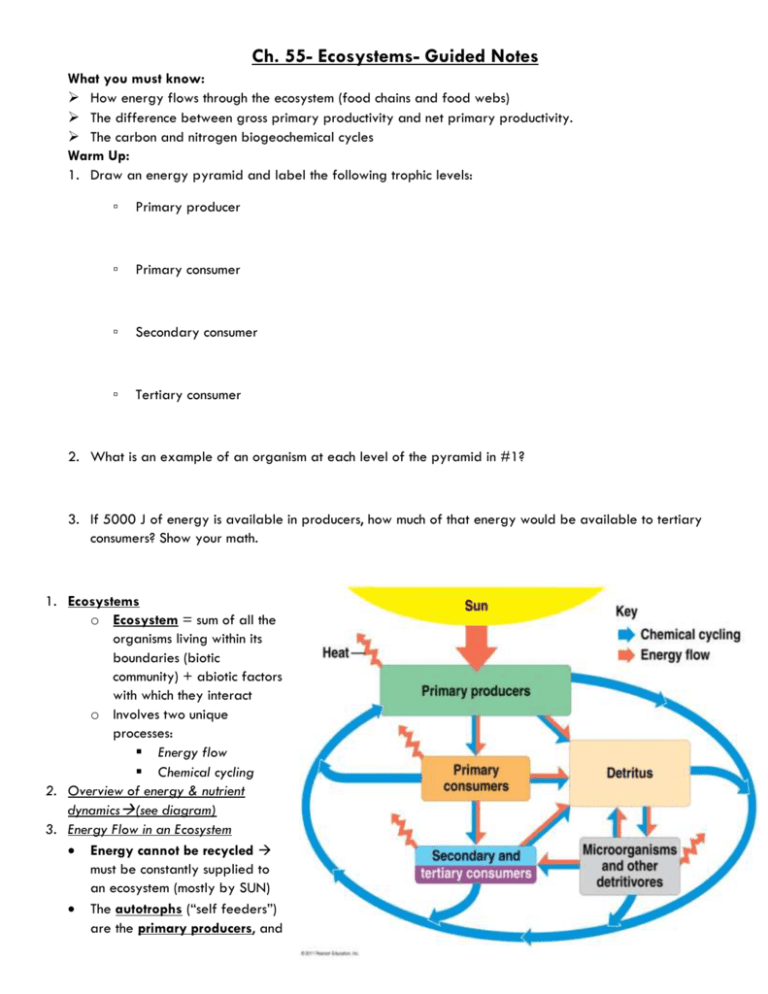
Ch. 55- Ecosystems- Guided Notes What you must know: How energy flows through the ecosystem (food chains and food webs) The difference between gross primary productivity and net primary productivity. The carbon and nitrogen biogeochemical cycles Warm Up: 1. Draw an energy pyramid and label the following trophic levels: ▫ Primary producer ▫ Primary consumer ▫ Secondary consumer ▫ Tertiary consumer 2. What is an example of an organism at each level of the pyramid in #1? 3. If 5000 J of energy is available in producers, how much of that energy would be available to tertiary consumers? Show your math. 1. Ecosystems o Ecosystem = sum of all the organisms living within its boundaries (biotic community) + abiotic factors with which they interact o Involves two unique processes: Energy flow Chemical cycling 2. Overview of energy & nutrient dynamics(see diagram) 3. Energy Flow in an Ecosystem Energy cannot be recycled must be constantly supplied to an ecosystem (mostly by SUN) The autotrophs (“self feeders”) are the primary producers, and are usually photosynthetic (plants or algae). o They use light energy to synthesize sugars and other organic compounds. Heterotrophs (“other feeders”) – can’t make own food o Heterotrophs are at trophic levels above the primary producers and depend on their photosynthetic output. Herbivores that eat primary producers are called primary consumers. Carnivores that eat herbivores are called secondary consumers. Carnivores that eat secondary consumers are called tertiary consumers. Another important group of heterotrophs is the detritivores, or decomposers. They get energy from detritus, nonliving organic material, and play an important role in material cycling. Main decomposers: fungi & prokaryotes 4. Primary Production Primary production = amt. of light energy that is converted to chemical energy Affected by: Light availability (↑ depth, ↓ photosynthesis) and Nutrient availability (N, P in marine env.) Key factors controlling primary production: o Temperature & moisture o A nutrient-rich lake that supports algae growth is eutrophic. Gross primary production (GPP): total primary production in an ecosystem Net primary production (NPP) = gross primary production minus the energy used by the primary producers for respiration (R): o NPP = GPP – R o NPP = storage of chemical energy available to consumers in an ecosystem 5. Net primary production of different ecosystems 6. Energy transfer between trophic levels is typically only 10% efficient Production efficiency: only fraction of E stored in food Energy used in respiration is lost as heat Energy flows (not cycle!) within ecosystems ****10% transfer of energy from one level to next**** Ecological pyramids give insight to food chains o Loss of energy limits # of top-level carnivores o Most food webs only have 4 or 5 trophic level o Pyramid of Biomass Pyramid of Numbers The dynamics of energy through ecosystems have important implications for the human population 7. Matter Cycles in Ecosystem Biogeochemical cycles: nutrient cycles that contain both biotic and abiotic components organic inorganic parts of an ecosystem Nutrient Cycles: water, carbon, nitrogen, phosphorus Water Cycle Carbon Cycle o CO2 removed by photosynthesis, added by burning fossil fuels Nitrogen Cycle o Nitrogen fixation: N2 plants by bacteria o Nitrification: ammonium nitrite nitrate; Absorbed by plants o Denitrification: Release N to atmosphere Phosphorus Cycle 8. Restoration Ecology o Bioremediation: use of organisms (prokaryotes, fungi, plants) to detoxify polluted ecosystems o Bioaugmentation: introduce desirable species (eg. nitrogen-fixers) to add essential nutrients Practice: Food Web 1. For the food web, label each organism: (Some may have more than one label) P = producer 1 = Primary Consumer 2= Secondary Consumer 2. Now label each animal as either a: H = herbivore C = carnivore 3 = Tertiary Consumer O = omnivore

